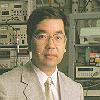- JST Home
- /
- Strategic Basic Research Programs
- /
 ERATO
ERATO- /
- Research Area/Projects/
- Completed/
- GONOKAMI Cooperative Excitation
GONOKAMI Cooperative Excitation

Research Director: Makoto Gonokami
(Professor, School of Engineering, The University of Tokyo)
Research Term: 1997-2002
The Gonokami Cooperative Excitation project was aimed at creating and understanding new material phases in which particles and quasi-particles are produced under very high density and low temperature, and exploring their properties for future applications.
Research Results
Laser cooling and manipulation of strontium atoms with a spin-forbidden transition: A new two-stage all-optical method for the rapid cooling of Bosonic and Fermionic isotopes of strontium atoms has been developed. This scheme, based on a very narrow linewidth laser developed in this project, has allowed the laser cooling of strontium atoms to be achieved down to 400 nK within a short time of 150 ms. By confining these ultracold atoms into an optical trap, both Bosonic and Fermionic isotopes were cooled down to a nearly quantum degenerate regime. Additionally, a method of high-resolution spectroscopy was invented, which is based upon a technique involving the light-shift manipulation of ultra-cold strontium atoms. Based on this method, an ultimate atomic clock has been proposed.
Cooperative quantum phenomena in solids: An ensemble of the photoexcited high-density free carriers at 10 Kelvin was created in copper chloride by using ultra-short light pulses tuned to the levels of bound electron-hole pairs, called excitons. This excitation method was used to reduce excess carrier heating. The created dense exciton gas was transformed through a Mott transition into a new metallic phase due to screening effects. Additionally, an experimental apparatus was developed based on mid-infrared transient reflectivity measurements, which allowed the collective motion of ionized carriers around the plasma frequency to be detected. The transient reflectivity spectra showed that the low-temperature electron-hole plasma existed in optically excited direct-gap semiconductors in the form of small droplets.
Ultrafast optoelectronics with strongly correlated electronic systems: Strong nonlinearity and picosecond recovery of optical transparency were found in a one-dimensional cuprate, Sr2CuO3, which belongs to the family of high-temperature superconducting materials. A theoretical calculation that took into account the correlation of electrons revealed a great potential of this one-dimensional Mott insulator for high bit-rate all-optical switching.
Many body correlation effects of semiconductor optical nonlinearity: A polarization-sensitive technique was developed and employed to study higher order correlations among photo-excited carriers in semiconductors and semiconductor microstructures. The coherent optical nonlinearity was classified in terms of the short-range interactions between excitons with various memory depths, and the parameters of these interactions were measured experimentally. Numerical calculations that fully take into account the four-particle correlation effects were developed and perfectly reproduced the experiment for a two-dimensional exciton system.
Crystal-growth technique: An attempt was made to develop a MOVPE system for the crystal-growth of high-quality gallium nitride. In the obtained high-quality crystal, a condensation phase of electron-hole pairs was observed by mid-IR femtosecond spectroscopy.
















